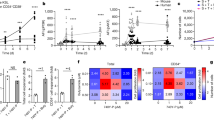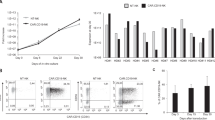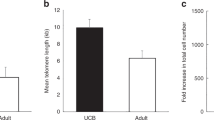Abstract
An artificial capillary culture/transduction technique has been developed for application in a phase I gene therapy clinical trial for HIV. The trial protocol involves isolation of CD4+ T-lymphocytes from a genetically matched HIV negative twin, retroviral transduction of equal numbers of cells with the ribozyme therapeutic and control genes, and expansion in Cellmax artificial capillary modules. Preclinical studies showed transduction efficiencies in the range of 3–30%, with preferential expansion of CD4+ lymphocytes over a culture period of 10–14 days. Over this time period, an average yield of 1.7 × 109 lymphocytes was readily attainable from 5 × 107 CD8-depleted lymphocytes. In addition, a sensitive and reliable quantitative competitive PCR method was developed to assess the levels of transduction before infusion into the recipient. The transduction data suggest that the efficiency of retroviral transduction was affected by the presence of inhibitory factors present in the virus preparations or generated as a result of the transduction process itself. It is hypothesised that the method of transduction could significantly affect the extent of this inhibition, and thus impact on clinical efficacy of retrovirus mediated gene therapy.
This is a preview of subscription content, access via your institution
Access options
Subscribe to this journal
Receive 12 print issues and online access
$259.00 per year
only $21.58 per issue
Buy this article
- Purchase on Springer Link
- Instant access to full article PDF
Prices may be subject to local taxes which are calculated during checkout






Similar content being viewed by others
References
Sun LQ et al. Ribozyme-mediated suppression of Moloney murine leukemia virus and human immunodeficiency virus type I replication in permissive cell lines Proc Natl Acad Sci USA 1994 91: 9715–9719
Sun LQ, et al. Resistance to human immunodeficiency virus type 1 infection conferred by transduction of human peripheral blood lymphocytes with ribozyme, antisense or polymeric trans-activation response element constructs Proc Natl Acad Sci USA 1995 92: 7272–7276
Blaese RM et al. T lymphocyte-directed gene therapy for ADA− SCID: initial trial results after 4 years Science 1995 270: 475–480
Bordignon C et al. Gene therapy in peripheral blood lymphocytes and bone marrow for ADA− immunodeficient patients Science 1995 270: 470–474
Hege KM, Roberts MR . T cell gene therapy Curr Opin Biotechnol 1996 7: 629–634
Leavitt MC, Yu M, Wong-Staal F, Looney DJ . Ex vivo transduction and expansion of CD4+ lymphocytes from HIV + donors: prelude to a ribozyme gene therapy trial Gene Therapy 1996 3: 599–606
Woffendin C et al. Expression of a protective gene prolongs survival of T cells in human immunodeficiency virus-infected patients Proc Natl Acad Sci USA 1996 93: 2889–2894
Rudoll T et al. High-efficiency retroviral vector mediated gene transfer into human peripheral blood CD4+ T lymphocytes Gene Therapy 1996 3: 695–705
Morgan JR et al. Retrovirus infection: effect of time and target cell number J Virol 1995 69: 6994–7000
Kotani H et al. Improved methods of retroviral vector transduction and production for gene therapy Hum Gene Ther 1994 5: 19–28
Bahnson AB et al. Centrifugal enhancement of retrovirus-mediated gene transfer J Virol Meth 1995 54: 131–143
Bunnell BA et al. High-efficiency retrovirus-mediated gene transfer into human and nonhuman primate peripheral blood lymphocytes Proc Natl Acad Sci USA 1995 92: 7739–7743
Forestell SP, Bohnlein E, Rigg RJ . Retroviral end-point titer is not predictive of gene transfer efficiency: implications for vector production Gene Therapy 1995 2: 723–730
Palsson B, Andreadis S . The physico-chemical factors that govern retrovirus-mediated gene transfer Exp Hematol 1997 25: 94–102
Chuck AS, Palsson BO . Consistent and high rates of gene transfer can be obtained using flow-through transduction over a wide range of retroviral titers Hum Gene Ther 1996 7: 743–750
Imbert AM et al. Highly efficient retroviral gene transfer into human primary T lymphocytes derived from peripheral blood Cancer Gene Ther 1994 1: 259–265
Mavilio F et al. Peripheral blood lymphocytes as target cells of retroviral vector- mediated gene transfer Blood 1994 83: 1988–1997
Sekine T et al. A feasible method for expansion of peripheral blood lymphocytes by culture with immobilized anti-CD3 monoclonal antibody and interleukin-2 for use in adoptive immunotherapy of cancer patients Biomed Pharmacother 1993 47: 73–78
Nakamura Y et al. Large-scale culture system of human CD4+ helper/killer T cells for the application to adoptive tumour immunotherapy Br J Cancer 1992 66: 20–26
Shimizu K et al. A high density cell culture system for generation of human lymphokine-activated killer (LAK) cells for clinical use in adoptive immunotherapy J Clin Lab Immunol 1990 32: 41–47
Paul RW et al. Increased viral titer through concentration of viral harvests from retroviral packaging lines Hum Gene Ther 1993 4: 609–615
Kaptein LC, Greijer AE, Valerio D, van Beusechem VW . Optimized conditions for the production of recombinant amphotropic retroviral vector preparations Gene Therapy 1997 4: 172–176
Miller AD, Rosman GJ . Improved retroviral vectors for gene transfer and expression Biotechniques 1989 7: 980–990
Zachar V, Thomas RA, Goustin AS . Absolute quantification of target DNA: a simple competitive PCR for efficient analysis of multiple samples Nucleic Acids Res 1993 21: 2017–2018
Sun LQ, Wang L, Gerlach WL, Symonds G . Target sequence-specific inhibition of HIV-1 replication by ribozymes directed to tat RNA Nucleic Acids Res 1995 23: 2909–2913
Author information
Authors and Affiliations
Rights and permissions
About this article
Cite this article
Knop, A., Arndt, A., Raponi, M. et al. Artificial capillary culture: expansion and retroviral transduction of CD4+ T-lymphocytes for clinical application. Gene Ther 6, 373–384 (1999). https://doi.org/10.1038/sj.gt.3300822
Received:
Accepted:
Published:
Issue Date:
DOI: https://doi.org/10.1038/sj.gt.3300822



